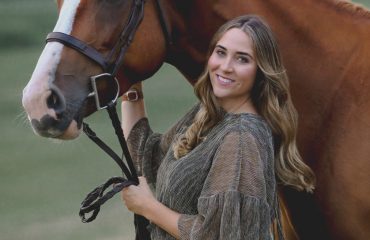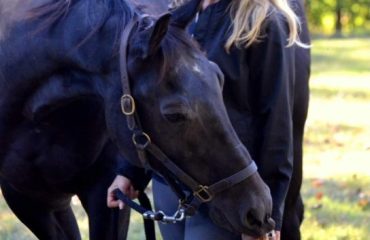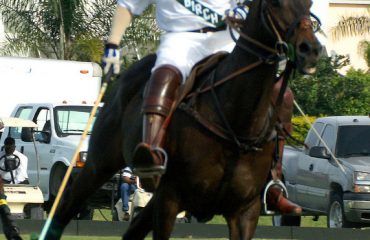
Lisa Lourie with Kirschwasser SCF (Amaretto D’Arco x Werly Chin de Muze). Both parents were owned and campaigned by Spy Coast Farm. Kirschwasser SCF is a homebred gelding who won a grand prix this year, participated in this year’s Nations Cup at WEF (for Ireland) and is jumping 5 stars.
By Britney Grover
Portraits by Isabel J. Kurek
As a mother and ICU nurse, Lisa Lourie’s journey with horses began when her daughter started riding at 8 years old and Lisa decided to take up riding alongside her. Soon they purchased their first horse and pony, and began looking for a horse property. In 2003, Lisa founded Spy Coast Farm — a name now well-known within the entire equestrian community. What began as a private farm has expanded to encompass locations in Kentucky, North Carolina and Florida, with operations ranging from breeding, young horse development and competition to fitness, rehabilitation, retirement and research.
Spy Coast’s acclaimed stallion offerings now include Royce, shown by Margie Engle, and Brianne Goutal’s Nice de Prissey. In the show ring, Spy Coast Farm horses have earned top placings with Ireland’s Shane Sweetnam, whose Sweet Oak Farm bases out of Spy Coast facilities. This year, the Irish Show Jumping Team honored Lisa for her support both of Shane and the sport, and Shane was named to Ireland’s Nations Cup team with homebred Kirschwasser SCF — who then went on to take second place in his first-ever Nations Cup.
When you first created Spy Coast Farm, what was the goal? Did you have any idea it would turn into the massive establishment it is now?
I began Spy Coast Farm in 2003, and at that time it was a small private farm on Long Island. From the start, it was a place of learning and growth. By 2007 I had the idea that the wonderful mares in the high junior jumper ring were terrific resources that should be used more for breeding. Some folks were doing it, of course, but not very many. My goal was (and remains) to grow and bring more recognition to the warmblood breeding industry in America.
I didn’t realize at the time that beyond breeding, it was the training and development of these horses that also needed to be addressed here in the U.S. I had no idea that so many aspects of the show horse industry would affect my breeding business, so my business has grown to address these issues.
 Were there experiences earlier in your life that gave you the initiative and motivation it took to see and take the opportunity with retired horses and breeding?
Were there experiences earlier in your life that gave you the initiative and motivation it took to see and take the opportunity with retired horses and breeding?
My parents always told me that I could do whatever I wanted in life as long as I was willing to work for it. I chose nursing as a career because it suited my inherent skill set and because it gave me the flexibility to travel and to work part-time, should I have children. When I felt that I was badly managed in my first job, I decided that I had better learn about management, so I got my master’s in health care management. From there, I moved on to other jobs with the Massachusetts Department of Public Health AIDS Program and then with the CDC. Eventually I moved to Virginia, started a family and went back to ICU/CCU nursing part time. All this seemed natural me, to grow with whatever opportunities presented themselves. So when the light bulb went on about breeding older performance horses, I knew I could do it. The technical challenge of getting older mares pregnant seemed surmountable and certainly was.

Kirschwasser SCF
Where do you think your determination comes from?
A desire to learn how to fix something. I am at heart a manager and a fixer. I seem destined to do both and I love creative problem-solving.
You’re a partner with the Tryon International Equestrian Center. Were you happy with how the World Equestrian Games went? What’s been your next project?
WEG was a challenge, to say the least. I believe the field of play was one of the best ever offered and I remain proud of our partnership’s accomplishments. We had less than half of the usual time to pull the games off and managed to do so despite many unforeseen challenges. At the end of the day, Mother Nature has the ability to humble us all.
The partnership has no end of projects to work on. Of the projects I will be working on, the Developing Jumper Final at TIEC is my next big focus.
How did you first start working with Shane Sweetnam?
About 13 years ago, my daughter, Julia, and I were in Wellington for the season and her trainer was pregnant and couldn’t travel at the time. The barn where we boarded her children’s jumper had hired Shane to help with the jumpers. She walked a course with him and it was obvious that they understood each other — I think she was champion that very first week with him. The next week, I saw a horse walking down the road that I literally fell in love with. It turned out that Shane owned it and was marketing him as a grand prix prospect. I ended up buying and sponsoring Shane on that horse, who eventually ended up being Julia’s best high junior jumper.
Outside of horses, what are your hobbies or interests? What do you do in your free time?
Free time? What’s that?
No, I really try to maintain a balance, though I’m not always successful. I should do more yoga and riding. I’m pretty good at prioritizing time with my grown children, though.

Lisa with Chaqui Z (Chacco Blue x Quilina Z) a Spy Coast Farm stallion and one of their top competition horses. He was on the winning team at the EU championships.
What are your children doing now?
My daughter, Julia (27), has a full-time job at the Bard Prison Initiative. She loves her job, is immersed in social and criminal justice reform. She’s a master at networking. My son, Alex (29), is a budding photojournalist who loves to work in hazardous environments. He just got back from Syria and Iraq.
What are your goals for Spy Coast Farm?
To get to consistent profitability and to become a center of excellence for sporthorses. We’re currently partnering with U.K.’s Gluck Equine Research Institute in some fascinating metabolic and growth research, which will hopefully further inform breeders on how to manage sporthorse growth rates. Our goal is to try to maximize potential and minimize growth-rate-related problems. We are also engaged in rehabilitation and fitness research in order to better determine how to achieve optimal fitness levels for sporthorses. I also plan to improve our internship programs and provide other opportunities for equine practitioners.
For more information, visit www.spycoastfarm.com.
Photos by Isabel J. Kurek













